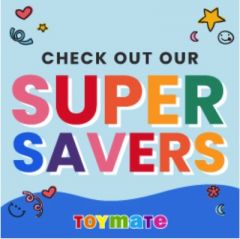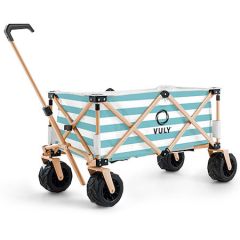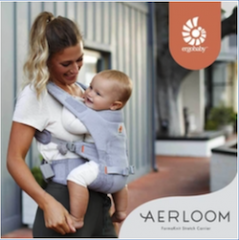Engaging in Play With Your Infant Work / Play / Leisure Suitable for stages: 3 - 6 Months
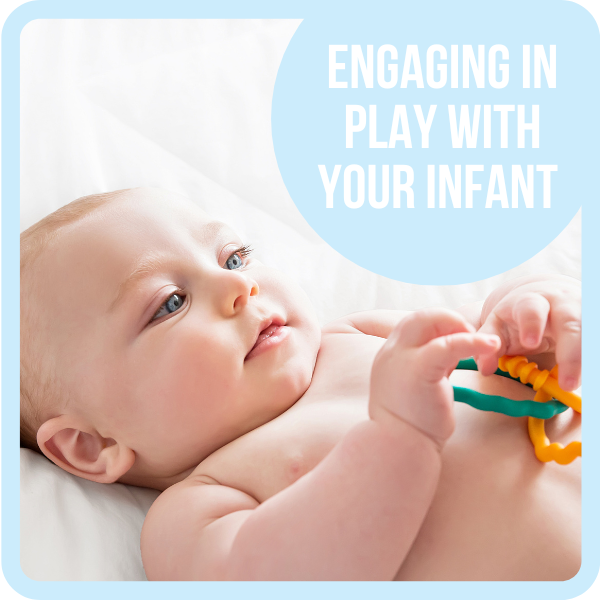

Updated 14 February 2023
Are you wondering, how the heck can I interact, play and engage my infant? What can they do? What do they like at this age? Read on, and you will find out all about your wonderful infant and the skills you can work on together. This can be as fun for you as it is for them with lots of giggles along the way!
Between 3 and 6 months is a great age for development where your baby is working out their body and starting to get the hang of controlling their neck, upper body & torso. They are still mostly comfortable laying horizontal unless they have support such as in a carrier or in-arms. Even though they are out of the 'fourth trimester' period, they still need lots of help, attention and touch to thrive. Their sensory system is thirsting for input to build a brain body connection with solid foundations. Providing a rich sensory diet is one of the most important things you can do for you child to set them up for later educational success.
Your social baby
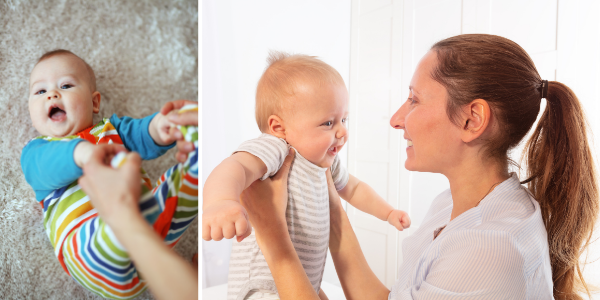
Babies this age love to stare at faces (including their own reflection) and practice interacting back and forth through making faces and vocalisations. For all the hard work you do as a parent, your payment, for now, is to enjoy these moments of play and the spontaneous sense of humour your baby can surprise you with. They will laugh when play is super amusing and something unexpected happens (Peek-a-boo!). Your baby will watch and respond excitedly when someone talks or approaches them. You can have entertaining 'conversations' where they can now make vocal noises to get attention and can ‘answer’ back when talked to or may enjoy babbling to themselves. Singing and music will also be enjoyed during playtime. They are further developing their distinctive cries and body language to communicate their different needs and you are learning their distinctive language and getting better at responding.
In essence, their best plaything will be you, or their other parent, and other caregivers or siblings.
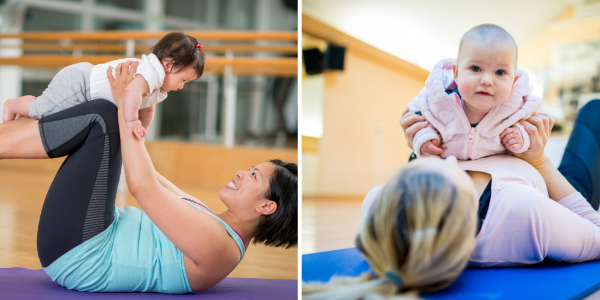
Physical Play
If you don't already, this is a great time to make tummy time a regular part of your day (starting with your baby chest to chest on you) to help your baby to build head/neck, shoulder and core body strength.
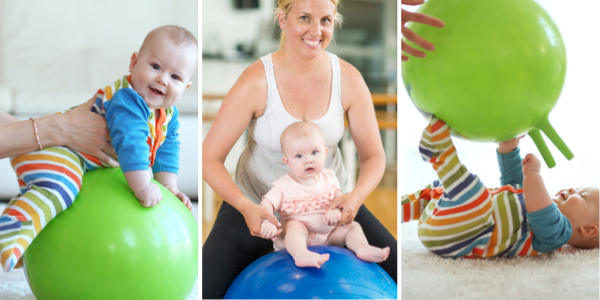
Your baby will benefit from having a play mat which has some cushioning (and better still, some waterproof and easy clean properties such as the Skip Hop Doubleplay Reversible Playmat or a large yoga mat) so they can enjoy lots of floor-based play with you. You can make it fun for your baby by getting down on the floor with them and on your chest for tummy time (sneak in some yoga while you are there). Exercise balls are great for bouncing on and another way to do tummy time play.
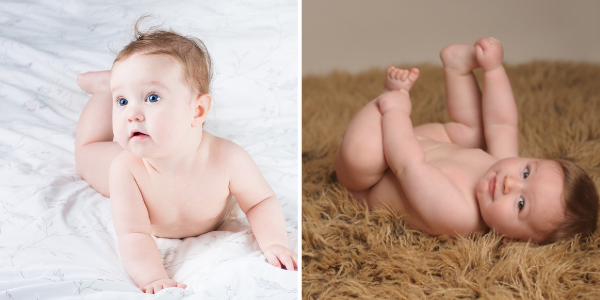
Your baby will love to have their nappy off for some no-nappy-time, just watch for puddles and have a towel or absorbent sheet to soak any messes up. This can also be a good time to do a massage if they enjoy it.
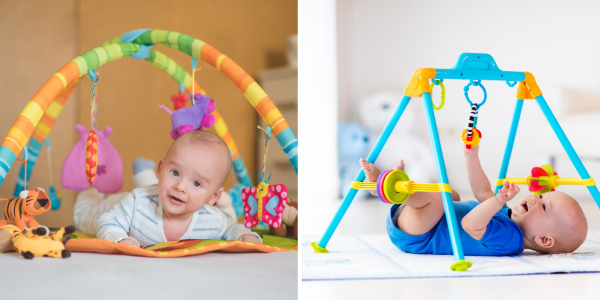
Otherwise, floor-based play will be fun and engaging with a mobile (this one from Lovevery is amazing) and other simple toys that they will enjoy reaching for and grabbing such as chew-safe rattles, easy-grip balls (such as an OBall), soft or indestructibles books and a baby-safe mirror.
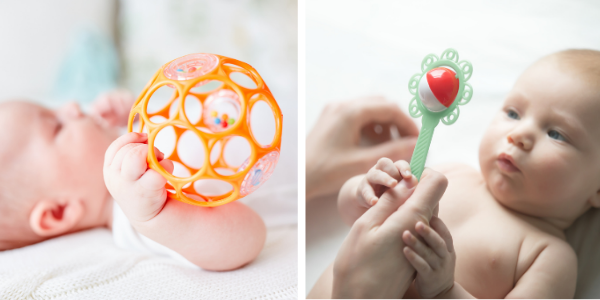
Hand-Eye Coordination
From 5 months, your baby can use their eyes together to see depth and distance and their colour vision is now considered to be good. This will mean that bright and 3D toys or objects will now be more interesting to your baby. With toys, sometimes less is more, so only offer 1 or 2 toys at a time so your baby can engage with the objects instead of getting distracted.
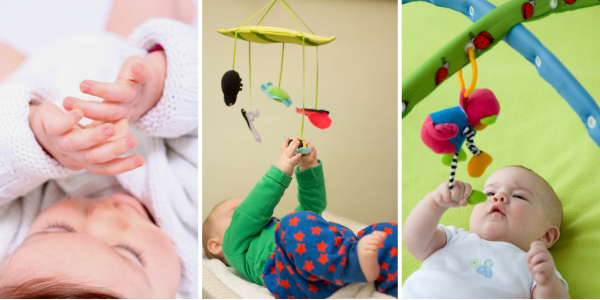
They are discovering their hands, where you can watch them studying their hands intently between 3 - 5 months. At around 4 months, toys that are easy to grasp can be placed in their hands and they will hold the grasp, however this is mostly involuntary. They will usually start to reach for objects with both hands (which will always go to the mouth for exploration) at around 4 - 5 months and start to lose their involuntary grasp reflex as their movements become voluntary and purposeful. Once they can grab with two hands (bidextrous approach) successfully, they then start working on grabbing with one hand (unidextrous approach) at a time from around 5 - 6 months. To help them work on their hand eye coordination, why not have fun with bubbles - blow bubbles and show your baby how to swat at them.
Working on Rolling to Sitting
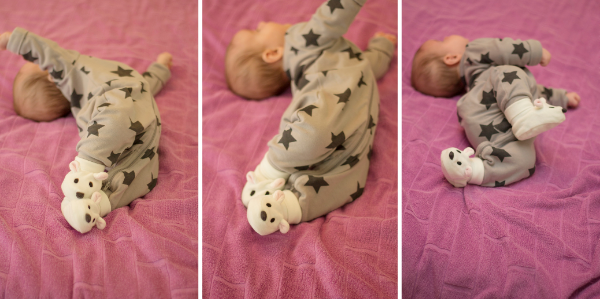
When your baby figures out how to move their legs and arms and lift their head, they can start to roll over from front to back and then back to front on purpose. Give them plenty of time to practice their moves while they are active alert. Be careful putting your baby on a bed or even for a second unattended on a change table because even if your baby has never rolled over before, you don't want them doing it for the first time right off to the ground! Achieving the rolling milestone is a big one and such a special moment to watch. For your baby, starting to roll can be exciting but unsettling at the same time and can interfere with them being able to settle to sleep. All they may want to do is practice their new moves! Sometimes, they will roll once and then not do it again for sometime. It may appear that they are regressing at times, but this is usually not anything to worry about, their development isn't always linear, there are peaks and troughs. As long as overall they are progressing their development in an upwards trend, there is nothing to worry about.
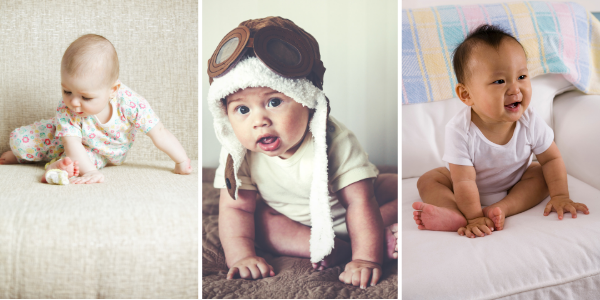
Once your baby has mastered rolling in both directions, the next step is to work on getting from lying to sitting. Give them plenty of time on the floor to work out this next move including lots of tummy time. The average age for sitting up unsupported is 6 months, however your baby will do it when they are ready to move from the horizontal plane to the vertical plane.
To help them work on their seated balance, you can try sitting them up for short periods of time and supporting them with your hand, body and/or have a u-shaped pillow on standby around them to stop them hitting their head. It is important however for your baby to learn to push through their arms into sitting and to use their own arms to stop them from falling from sitting. If you sit them up too early and too often in a supportive seat or with too much support, this can interfere with their natural development of seated balance.
The Magic of Touch
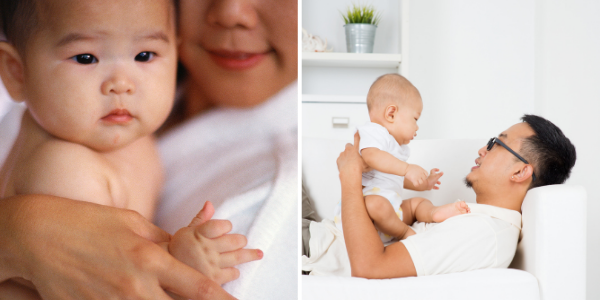
Touch is still (and will be throughout their development), such a fundamental element in your baby learning about their bodies and their bodies learning about their environment. Touch is a powerful tool in helping to develop the vestibular and sensory systems. Your baby will still love being carried, so make sure you have a comfortable carrier on hand at all times. Some simple activities you can do:
- Seat your baby on your lap as if you were a seat and let them hold a book or toy. This is a great opportunity for bonding kisses and cuddles.
- Help your baby to stand staight legged on your lap by holding their body or hands - this will strengthen your baby's legs and they will love the view.
- Help your baby to bounce by holding their hands to pull into a stand, then let them bend their kness and hips to bounce up and down.
Rocking & Swinging
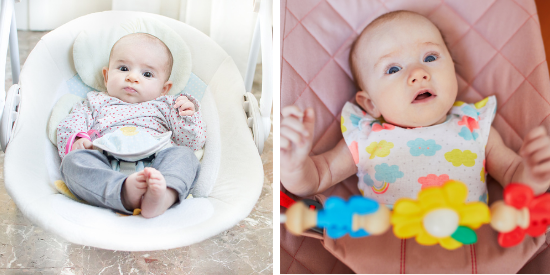
Your baby will still benefit from and enjoy the sensation of rocking and swinging. They can find the sensation exciting or soothing depending on if the movement is fast or slow and rhythmic. If you purchased any bouncers or swings for your baby as a newborn, they will continue to enjoy using these.
Some options include:
- Rocking Chair (from The Stork Nest) or Rocking Chair (from Mocka)- The rocking motion of the chair is calming for both you and your baby for relaxed feeds or reading time.
- Baby Swing (Baby Bunting eBay Store) - baby swings should be used in moderation, but can be an easy way to calm your baby and stimulate their vestibular system. As they grow, make swinging part of their daily routine.
- BabyBjorn Bouncer (Baby Bunting eBay Store) - great for popping your baby in for short periods while you use the bathroom or cook dinner. Any leg movements they make will cause the bouncer to rock up and down. Easy to fold up to store out of the way when not being used.
- Beaba Up & Down Bouncer (eBay or Amazon Au) - great for parents with limited ability to bend and lift from below knee level or need a bouncer at seated height. Like all devices, limit the time your baby spends in these and change their position often.
Play dates
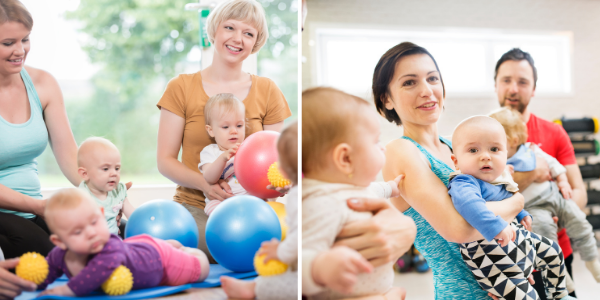
Why not mix play time with your baby with socialising by joining a mums and bubs exercise class or mother's group? Your baby's won't interact much at this age, but it's great for you to get out of the house and meet other parents with similar aged babies. It's a great opportunity to make some friends and as your babies grow you can continue to have play dates/mummy meet-ups.
Playtime with your baby is a great time to laugh and play to balance out the harder parts of parenting life. The gift our babies give us is to experience being in the moment without a thought to the past or the future. For them, there is only now. As adults, we can forget how to be truly present and how natural and great it feels. Seeing the world through their eyes as they experience for the first time and achieve for the first time can be a delight and you won't want to miss a thing!
Happy times!
Shopping destinations to explore:
Find Children's Books & Baby's & Kids Educational Toys & Activities from Biome Eco Stores
Books, Baby Toys 0-2 years & Baby Needs from Lime Tree Kids
Bath Toys & Baby Toys from The Stork Nest
Shop books for 0-2 year olds & Toys for 0-1 year olds from Amazon.com.au
Shop Baby Toys (0 - 12 months) from eBay.com.au
Written by Anna Noud
Anna is a mother of 2 boys and an Occupational Therapist, holding a Bachelor of Occupational Therapy with Honours from the University of Newcastle, NSW, Australia. A lifelong learner with a passion for everything health-related and a drive to improve the lives of Mothers and the babies who will be the leaders of our future. The most important asset we have in this life is our health, well-being, and happiness. Writing for BabyPeg is a passion project alongside life tripping in the caravan, parenting, and working as an OT to help people with disabilities fulfill their potential. Find me on LinkedIn or message me through the BabyPeg Facebook page.
Please note: Above all, any information on this website aims to provide general ideas for informational and educational purposes only. We encourage users to investigate several information sources, including, where necessary, independent individualised medical advice before making any decisions which could affect you or your child’s health or wellbeing.
BabyPeg participates in various affiliate programs and may earn a commission for referring our users through the links provided. This is at no additional cost to our users. We take great care in choosing products and services which align with the mission of promoting better health and wellness for our BabyPeg community. Where possible, products are tried and tested by us. To continue to provide BabyPeg as a free service and reach as many parents as possible, we appreciate your support in using the link provided to purchase if you decide the product is right for you.




